
Jump to:
As is clear from the well-known saying, “An apple a day keeps the doctor away”, the importance of apples is understood worldwide. In Japan, as well, the health-giving properties of apples have been known for centuries. Indeed, after the Second World War, when food rations were scarce, a note from one’s doctor was required to purchase an apple. In more recent times, Japanese apples have gained popularity around the world for their large size and sweetness, and they are one of the most popular Japanese fruits.
In this article, we shall look at the history of Japanese apples, the major cultivation areas, and popular types with their flavor profiles. We shall look at some expensive Japanese apples, some cultural aspects, the nutritional benefits of apples, and some popular ways of consuming apples, and rounding up by looking at the popularity of Japanese apples overseas.
History Of Japanese Apples
Although apples have been cultivated around the world since prehistoric times, they have a much shorter history in Japan. Records of the Japanese word for apples (“Ringo”) being used go back to the Heian period (around the 10th Century) when small, hard, wild species entered Japan from China.
These were very different from what we know as Japanese apples today and were referred to as “Wa ringo” (literally Japanese apple) and “Ji-ringo.” Indications are that these were most used as temple offerings.
The trigger for the development of Japanese apples as we know them now came in 1871, when 75 varieties of apples were imported from the U.S. Seedlings were distributed for trial production and these were found to grow well in the relatively cold regions of the north of Japan. Apples soon assumed an important role for the farmers as they produced fruit even when rice failed due to the cold weather.
They were first called “western apples” to distinguish them from the “Wa-ringo”, but with their burgeoning popularity due to their quality and size, they soon completely subsumed the market and became known merely as apples. Apple cultivation flourished in the Meiji period, but their production was curtailed by the government upon the outbreak of the Pacific War. Apple growing grew in popularity again after the war, however, when the depleted orchards were rebuilt, and research flourished on new varieties.
Major Cultivation Areas Of Japanese Apples
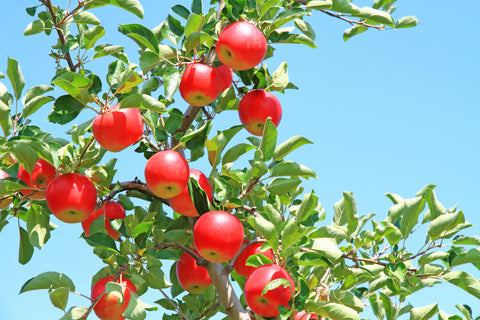
It is said that the ideal environment for apples is cool weather with low rainfall, and the Tohoku region of Japan ticks all the boxes. In particular, Aomori prefecture is well known for its apple cultivation and accounts for over 60% of apples produced in Japan, which amounts to a whopping 500,000 tons of apples per year. The next highest apple-producing prefecture is Nagano, which accounts for approximately one-sixth of the apples produced in Japan. With some notable exceptions described below, the majority of apples are picked between September and January.
Popular Types Of Japanese Apples
So let us look at some famous types of Japanese apples.
Fuji
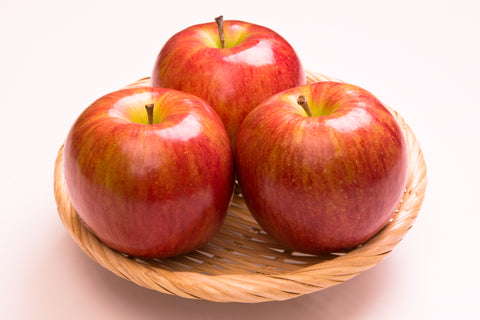
The clear leader, in terms of popularity, is the Fuji brand, which accounts for approximately 50% of the total market share. Fuji is a cross between two U.S. varieties, the Red Delicious and the Virginia Rails Janet.
A popular misconception is that this apple is named after Mt. Fuji. The truth, however, is that its name hails from the town of Fujisaki in Aomori, where it was developed.
These apples are round and large, averaging 75 mm in diameter and weighing approximately 300-400 g, and it is also known for its long shelf life. Its mellow taste has been likened to that of Nashi (Japanese pears).
Tsugaru
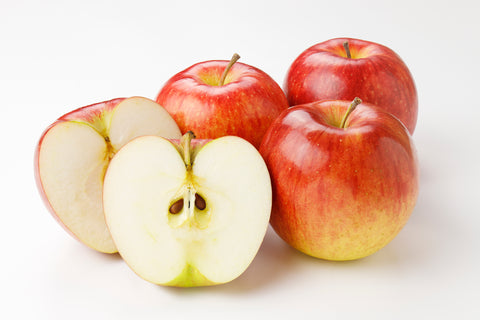
The Tsugaru brand, also from Aomori prefecture, is the next most commonly produced brand of apple in Japan. As previously noted, most apples are picked between September and January, but the Tsugaru ripens in August. It is a cross between the Golden Delicious and Benidama varieties and is characterized by its sweet taste with low acidity and juiciness.
Orin
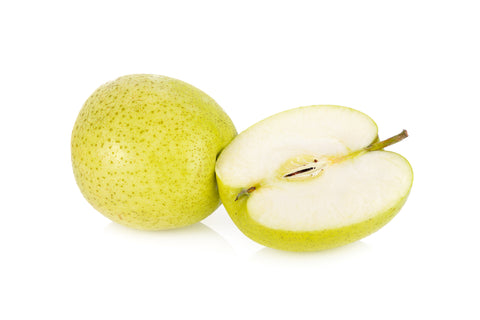
The Orin apples are yellow-green apples with a strong sweet taste and a mellow aroma.
yellow-green apple. The word “Orin” literally means the “king of the orchard” and this is a representation of the high esteem in which it is held. Although, at first, it appears to have a strong acidity, it is characterized by its sweetness and light, crispy texture. Whereas many varieties are only eaten raw, the texture of Orin means that it can also be used for cooking. Orin is a cross between the Golden Delicious and Indo varieties.
Haruka
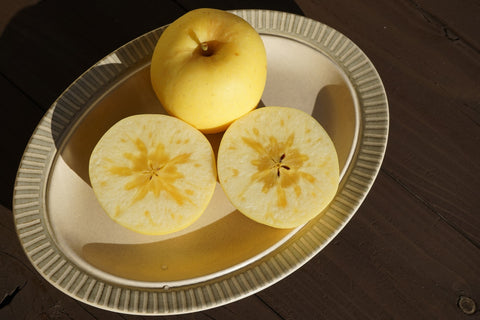
Haruka, first cultivated at Iwate University, has excellent sweetness, a nectar-like filling, and a good texture. It is characterized by its bright, beautiful yellow peel, which has been developed as a result of it being cultivated in a bag.
Toki

Toki is a yellow apple representative of Aomori Prefecture. It is characterized by its refreshing sweetness and pleasant aroma. Toki is a new variety registered in 2004. It has shallow yellow skin and pale yellow flesh. It is popular for its low acidity, full-bodied, refreshing sweetness, and crisp texture.
Kinsei
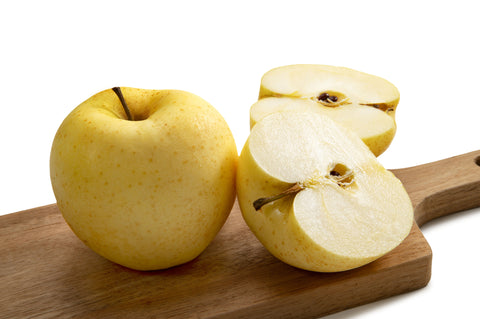
Kinsei is a large variety of apples, weighing approx. 350 g. Its peel is smooth from using the bag cultivation method. It is loved for its beautiful golden peel and rich sweetness.
The bagless "Kinsei" variety, sold as "Sun Kinsei," is juicier than the bagged variety, but it is less durable, so it is only available in stores for a short period of time.
Akane
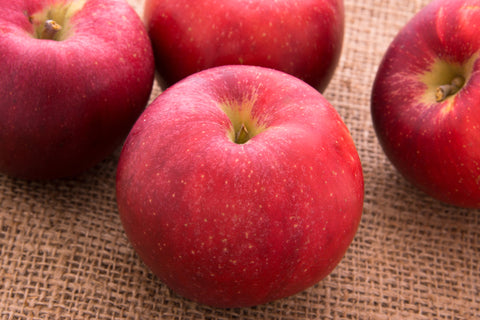
“Akane”, in Japanese, means “red”, and, as its name suggests, the “Akane” variety is a full-bodied dark, crimson-colored apple. It ripens in early to mid-September in its growing area (Morioka City, Iwate Prefecture), with no fruit loss before harvest. It has excellent longevity for an early ripening variety.
Mutsu
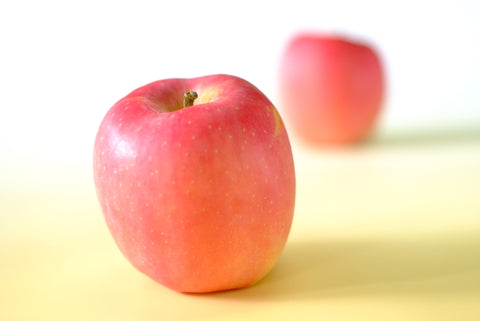
The fruits of “Mutsu” apples are large, weighing 400 to 500 grams. They have a moderate sweetness, a sour acidity, and a distinctive aroma. Considered unsuitable for heat processing due to its rough texture, they are almost exclusively eaten raw.
Expensive Japanese Apples
I am guessing that most people reading this will not have paid the equivalent of $20 for a single apple. However, that is the going rate for the Sekai-Ichi (literally “world’s best”) variety of apples. These sweet and juicy red-hued apples can weigh up to 1 kg. Their large size means that only a small number of fruit can be grown on a single tree. Careful attention is also given to make sure they have the right color and look.
Visitors to Japan are often surprised at the emphasis placed on the aesthetic as well as the functional aspects of fruit. If you balk at the price of these apples, you should remember that this is the country where a cantaloupe melon once sold for over $20,000 at auction.
Cultural Aspects Of Japanese Apples
As has been previously mentioned, Japanese apples are generally larger than their Western counterparts, and this leads to changes in the overall eating experience. The small size of western apples means that eating them is often a solitary endeavor, such as taking them to work as a dessert after your packed lunch or as a mid-morning snack.
The large size of apples in Japan, however, means that it is generally too big to eat yourself or carry it out of the house with you, and they tend to be cut up and shared amongst friends. Eating apples in Japan, therefore, tends to be more of a communal experience.
Are Japanese Apples Good For You?

The nutritional qualities of apples, as evidenced by the “apple a day” proverb are a common part of our folklore, but are Japanese apples really good for you?
The answer to this is a resounding “Yes!!!”
Apples are rich in dietary fiber and increase the number of good bacteria in the intestines. This stimulates the workings of the intestines and improves bowel movements.
Pectin, a type of soluble dietary fiber, helps to eliminate cholesterol from the blood and suppresses the rapid rise in blood sugar levels, thereby preventing lifestyle-related diseases such as arteriosclerosis.
Potassium helps to remove sodium (salt) from the body, which reduces elevated blood pressure and also helps to reduce swelling, and Vitamin C helps increase the absorption of iron, which helps prevent anemia. Apples also have antioxidant properties, improve immunity, and have a skin-beautifying effect.
They also contain malic acid. Malic acid breaks down lactic acid and converts it into energy, thus accelerating recovery from fatigue.
One apple (260 g) only contains 134 kcal. About 80% of an apple's composition is water, and eating an apple tends to fill you up. It has been noted that eating half an apple before a meal will help prevent overeating in the meal to follow and will also prevent a rapid rise in blood sugar levels.
Popular Ways Of Consuming Japanese Apples
The most common form of eating apples in Japan is raw after peeling them. Whereas it is true that some of the nutritional elements are lost by peeling apples, Japan tends to use a large number of pesticides, so peeling is recommended.
Unlike Western cuisine, Japanese food does not tend towards apple-dominated desserts (like apple pie, apple crumble, and apple strudel in the West). When used in cooking, it more often adds an accent to foods, such as curries or confectioneries.
If you are looking for some ways to use apples, you might like to try this Aojiru green juice or this recipe for Gateau Invisible, named because the apple pieces in this cake seem to disappear into the light batter that binds them.
Apples are also used in a wide range of confectionery, including those made by Aomori-based manufacturer Ragueneau, and it is also a popular flavor used in snacks like apple konjac jelly.
Japanese Apples Abroad
Japanese apples are not only enjoyed in Japan, but the rest of the world has been gaining an appreciation of these large, delicious apples. In fact, Fuji apples are now the most widely grown variety of apples in the world. Indeed, 70% of apples produced in China are Fuji In the U.S., as well, Fuji is ranked third in the U.S. Apple Association list of popular apples.
It is not only Fuji, though, and “Mutsu”, also described above, is a very famous variety in England. It was hailed the "King of apples" at a British Competition and is popularly known by the name "Crispin".
Japanese Apples - A Different Apple Eating Experience

Once you experience Japanese apples for the first time, you will realize that not all apples are the same. Originally cultivated as combinations of various American types of apples, Japanese brand apples now have a prime spot in the world and many people outside of Japan as well are drawn to their superior size and quality.
Their large size also has cultural ramifications and in contrast to the solitary apple-eating experience common in the West, in Japan, where apples are generally too large to eat on one’s own or take anywhere, apples tend to be shared with family members at home creating a truly communal experience.
Do you have a favorite type of Japanese apple? How do you think they compare with Western apples? Let us know in the comments.


0 comments